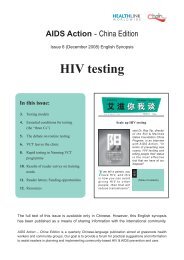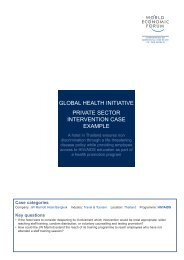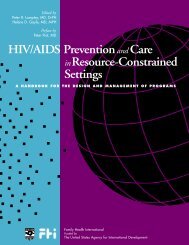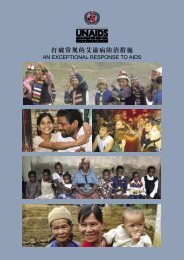The Training of Trainers Manual - UNFPA
The Training of Trainers Manual - UNFPA
The Training of Trainers Manual - UNFPA
You also want an ePaper? Increase the reach of your titles
YUMPU automatically turns print PDFs into web optimized ePapers that Google loves.
Handout 20 • Ten Facts about HIV/AIDS 20<br />
1. AIDS (acquired immunodeficiency syndrome) is caused by HIV, the human immunodeficiency<br />
virus, which damages the body’s defense (immune) system. People who have AIDS become weaker<br />
because their bodies lose the ability to fight all illnesses. <strong>The</strong>y start to become sick with a variety <strong>of</strong><br />
illnesses, and eventually many will die. <strong>The</strong>re is no cure for HIV/AIDS.<br />
2. <strong>The</strong> onset <strong>of</strong> AIDS can take up to ten years from the time <strong>of</strong> infection with HIV. <strong>The</strong>refore, a person<br />
infected with HIV may look and feel healthy for many years, but he or she can transmit the virus<br />
to someone else. New drug therapies called antiretroviral therapy (ART) can help a person stay<br />
healthier for longer periods <strong>of</strong> time, but the person will still have HIV and be able to transmit it.<br />
3. HIV is transmitted through the exchange <strong>of</strong> any HIV-infected body fluids. Transfer may occur during<br />
all stages <strong>of</strong> the infection. HIV is found in the following fluids: blood, semen (and pre-ejaculate<br />
fluid), vaginal secretions, and breast milk. <strong>The</strong>re is no known case <strong>of</strong> getting the virus from saliva<br />
while kissing. However, if a person has a cut in the mouth, he or she could possibly get HIV from<br />
kissing an infected person who also has a cut or open sore. <strong>The</strong> virus can only survive for a short<br />
time outside the body, so it cannot be transmitted through touching an infected person or sharing<br />
ordinary objects such as plates, eating utensils, and clothes.<br />
4. Worldwide, HIV is most frequently transmitted sexually. During sexual intercourse, body fluids mix<br />
and the virus can pass from the infected person to his or her partner, especially if there are tears<br />
in vaginal or anal tissue, wounds, or other sexually transmitted infections (STIs). Girls and young<br />
women are especially vulnerable to HIV infection because their vaginal membranes are thinner and<br />
more susceptible to infection than those <strong>of</strong> mature women.<br />
If an HIV-positive man has sex with a woman and does not use a condom, the man’s semen can<br />
carry the virus into the woman’s bloodstream through a tiny cut or sore inside her body, which can<br />
be so small that she does not know it is there. If an HIV-positive woman has sexual intercourse with<br />
a man without a condom, her vaginal secretions can transmit HIV into the man’s blood through a<br />
sore on his penis or through his urethra, the tube that runs down his penis.<br />
5. People who have STIs are at greater risk <strong>of</strong> being infected with HIV/AIDS and <strong>of</strong> transmitting their<br />
infection to others. People with STIs should seek prompt treatment and avoid sexual intercourse or<br />
practise safer sex (non-penetrative sex or sex using a condom), and inform their partners. A person<br />
infected with an STI is five to ten times more likely to become infected with HIV. Additionally,<br />
people who have an STI are also at a greater risk <strong>of</strong> transmitting their infection to others.<br />
6. <strong>The</strong> risk <strong>of</strong> sexual transmission <strong>of</strong> HIV/AIDS can be reduced if people abstain from sex, if uninfected<br />
partners have sex only with each other, or if people have safer sex, that is, sex without penetration<br />
or with a condom. <strong>The</strong> only way to be completely sure to prevent the sexual transmission <strong>of</strong> HIV is<br />
by abstaining from all sexual contact.<br />
Section 4. Participant Handouts<br />
177

















